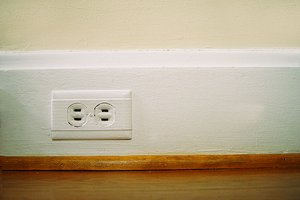Should You Replace Old Wiring?
If your house was built more than 40 years ago, replace old electrical wiring for safety.
Old wiring—even knob and tube wiring that dates back to the early 20th century—isn’t inherently dangerous, but unless you were around when the house was built, you can’t be sure the electrical system is up to code. Plus, materials such as wire insulation can deteriorate over time.
Safety issues with old wiring
Faulty wiring is the leading cause of residential fires, according to a 2009 study by the National Fire Prevention Association. And the older your house is, the greater the chances that old wiring might be outdated or unsafe.
If you don’t know the condition of your wiring, it’s worth paying a licensed electrician to inspect your electrical system. Expect to pay $150 to $300 for this service.
A good reason to consider replacing old wiring, aside from electrical home safty, is that some insurance carriers may refuse to insure houses with older electrical systems, or they may insist owners pay higher premiums.
Warning signs of outdated, old wiring
Some houses built in the 1960s and early 1970s have aluminum wiring instead of the standard copper wire. Aluminum wiring is considered a safety hazard because wiring connections may loosen up over time. Tiny gaps between the wiring and connectors may lead to overheating and possibly fires, especially when appliances and lighting fixtures are plugged into them.
A qualified electrician can inspect your home wiring to determine if it’s OK to leave your existing wiring in place. The addition of copper connectors, called pigtails, at circuit breakers and receptacles usually resolve potential problems with older aluminum wiring.
Upgrading to newer receptacles and wall switches also help prevent problems.
Faulty wiring is the leading cause of residential fires, according to a 2009 study by the National Fire Prevention Association. And the older your house is, the greater the chances that old wiring might be outdated or unsafe.
If you don’t know the condition of your wiring, it’s worth paying a licensed electrician to inspect your electrical system. Expect to pay $150 to $300 for this service.
A good reason to consider replacing old wiring, aside from electrical home safty, is that some insurance carriers may refuse to insure houses with older electrical systems, or they may insist owners pay higher premiums.
Warning signs of outdated, old wiring
- Breakers trip or fuses blow regularly.
- A tingling sensation when you touch a wall switch, appliance, or receptacle.
- Dimming and flickering lights.
- A burning smell in a particular room or from an appliance.
- Discolored outlets and switch plates that are warm to the touch.
- Ungrounded outlets throughout the house (ungrounded outlets accommodate only two-prong plugs).
- A lack of ground fault circuit interrupter (GFCI) outlets in your bathrooms, your kitchen, and other areas that may be exposed to damp and wet conditions.
- Your house was built more than 40 years ago.
Some houses built in the 1960s and early 1970s have aluminum wiring instead of the standard copper wire. Aluminum wiring is considered a safety hazard because wiring connections may loosen up over time. Tiny gaps between the wiring and connectors may lead to overheating and possibly fires, especially when appliances and lighting fixtures are plugged into them.
A qualified electrician can inspect your home wiring to determine if it’s OK to leave your existing wiring in place. The addition of copper connectors, called pigtails, at circuit breakers and receptacles usually resolve potential problems with older aluminum wiring.
Upgrading to newer receptacles and wall switches also help prevent problems.
 An outlet is ungrounded, and should be updated, if it only accommodates two-prong plugs. Image: Liz Foreman
An outlet is ungrounded, and should be updated, if it only accommodates two-prong plugs. Image: Liz Foreman
No comments:
Post a Comment